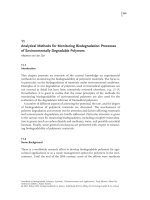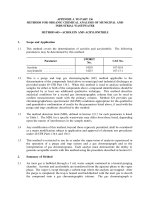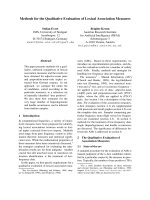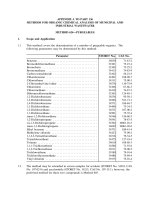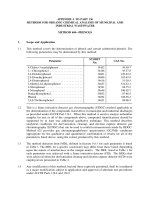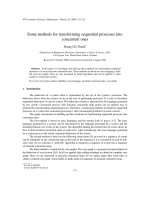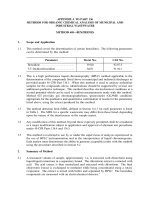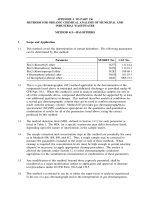Analytical Methods for Monitoring Biodegradation Processes of Environmentally Degradable Polymers
Bạn đang xem bản rút gọn của tài liệu. Xem và tải ngay bản đầy đủ của tài liệu tại đây (135.09 KB, 20 trang )
263
Analytical Methods for Monitoring Biodegradation Processes
of Environmentally Degradable Polymers
Maarten van der Zee
11.1
Introduction
This chapter presents an overview of the current knowledge on experimental
methods for monitoring the biodegradability of polymeric materials. The focus is,
in particular, on the biodegradation of materials under environmental conditions.
Examples of in vivo degradation of polymers used in biomedical applications are
not covered in detail but have been extensively reviewed elsewhere, e.g., [1 – 3] .
Nevertheless, it is good to realize that the same principles of the methods for
monitoring biodegradability of environmental polymers are also used for the
evaluation of the degradation behavior of biomedical polymers.
A number of different aspects of assessing the potential, the rate, and the degree
of biodegradation of polymeric materials are discussed. The mechanisms of
polymer degradation and erosion receive attention and factors affecting enzymatic
and nonenzymatic degradation are briefl y addressed. Particular attention is given
to the various ways for measuring biodegradation, including complete mineraliza-
tion to gasses (such as carbon dioxide and methane), water, and possibly microbial
biomass. Finally, some general conclusions are presented with respect to measur-
ing biodegradability of polymeric materials.
11.2
Some Background
There is a worldwide research effort to develop biodegradable polymers for agri-
cultural applications or as a waste management option for polymers in the envi-
ronment. Until the end of the 20th century, most of the efforts were synthesis
Handbook of Biodegradable Polymers: Synthesis, Characterization and Applications, First Edition. Edited by
Andreas Lendlein, Adam Sisson.
© 2011 Wiley-VCH Verlag GmbH & Co. KGaA. Published 2011 by Wiley-VCH Verlag GmbH & Co. KGaA.
11
264
11 Analytical Methods for Monitoring Biodegradation Processes
oriented, and not much attention was paid to the identifi cation of environmental
requirements for, and testing of, biodegradable polymers. Consequently, many
unsubstantiated claims to biodegradability were made, and this has damaged the
general acceptance.
An important factor is that the term biodegradation has not been applied con-
sistently. In the medical fi eld of sutures, bone reconstruction, and drug delivery,
the term biodegradation has been used to indicate degradation into macromole-
cules that stay in the body but migrate (e.g., UHMW polyethylene from joint
prostheses), or hydrolysis into low - molecular - weight molecules that are excreted
from the body (bioresorption), or dissolving without modifi cation of the molecular
weight (bioabsorption) [4, 5] . On the other hand, for environmentally degradable
plastics, the term biodegradation may mean fragmentation, loss of mechanical
properties, or sometimes degradation through the action of living organisms [6] .
Deterioration or loss in physical integrity is also often mistaken for biodegradation
[7] . Nevertheless, it is essential to have a universally acceptable defi nition of bio-
degradability to avoid confusion as to where biodegradable polymers can be used
in agriculture or fi t into the overall plan of polymer waste management. Many
groups and organizations have endeavored to clearly defi ne the terms “ degrada-
tion, ” “ biodegradation, ” and “ biodegradability. ” But there are several reasons why
establishing a single defi nition among the international communities has not been
straightforward, including:
1) the variability of an intended defi nition given the different environments in
which the material is to be introduced and its related impact on those
environments,
2) the differences of opinion with respect to the scientifi c approach or reference
points used for determining biodegradability,
3) the divergence of opinion concerning the policy implications of various defi ni-
tions, and
4) challenges posed by language differences around the world.
As a result, many different defi nitions have offi cially been adopted, depending on
the background of the defi ning organization and their particular interests.
However, of more practical importance are the criteria for calling a material “ bio-
degradable. ” A demonstrated potential of a material to biodegrade does not say
anything about the time frame in which this occurs, nor the ultimate degree of
degradation. The complexity of this issue is illustrated by the following common
examples.
Low - density polyethylene has been shown to biodegrade slowly to carbon dioxide
(0.35% in 2.5 years) [8] , and according to some defi nitions can thus be called a
biodegradable polymer. However, the degradation process is so slow in compari-
son with the application rate that accumulation in the environment will occur. The
same applies for polyolefi n – starch blends which rapidly loose strength, disinte-
grate, and visually disappear if exposed to microorganisms [9 – 11] . This is due to
11.3 Defi ning Biodegradability
265
utilization of the starch component, but the polyolefi n fraction will nevertheless
persist in the environment. Can these materials be called “ biodegradable ” ?
11.3
Defi ning Biodegradability
In 1992, an international workshop on biodegradability was organized to bring
together experts from around the world to achieve areas of agreement on
defi nitions, standards, and testing methodologies. Participants came from manu-
facturers, legislative authorities, testing laboratories, environmentalists, and
standardization organizations in Europe, United States, and Japan. Since this
fruitful meeting, there is a general agreement concerning the following key
points [12] .
1) For all practical purposes of applying a defi nition, material manufactured to
be biodegradable must relate to a specifi c disposal pathway such as compost-
ing, sewage treatment, denitrifi cation, and anaerobic sludge treatment.
2) The rate of degradation of a material manufactured to be biodegradable has
to be consistent with the disposal method and other components of the
pathway into which it is introduced, such that accumulation is controlled.
3) The ultimate end products of aerobic biodegradation of a material manufac-
tured to be biodegradable are CO
2
, water, and minerals and that the intermedi-
ate products include biomass and humic materials. (Anaerobic biodegradation
was discussed in less detail by the participants.)
4) Materials must biodegrade safely and not negatively impact the disposal
process or the use of the end product of the disposal.
As a result, specifi ed periods of time, specifi c disposal pathways, and standard test
methodologies were incorporated into defi nitions. Standardization organizations
such as CEN, ISO, and ASTM were consequently encouraged to rapidly develop
standard biodegradation tests so these could be determined. Society further
demanded nondebatable criteria for the evaluation of the suitability of polymeric
materials for disposal in specifi c waste streams such as composting or anaerobic
digestion. Biodegradability is usually just one of the essential criteria, besides
ecotoxicity, effects on waste treatment processes, etc.
In the following sections, biodegradation of polymeric materials is looked upon
form the chemical perspective. The chemistry of the key degradation process is
represented by Eq. (11.1) and (11.2), where C
polymer
represents either a polymer or
a fragment from any of the degradation processes defi ned earlier. For simplicity
here, the polymer or fragment is considered to be composed only of carbon,
hydrogen, and oxygen; other elements may, of course, be incorporated in the
polymer, and these would appear in an oxidized or reduced form after biodegrada-
tion depending on whether the conditions are aerobic or anaerobic, respectively.
266
11 Analytical Methods for Monitoring Biodegradation Processes
Aerobic biodegradation:
COCOHOCC
polymer residue biomass
+→ + + +
222
(11.1)
Anaerobic biodegradation:
CCOCHHOCC
polymer residue biomass
→+ ++ +
242
(11.2)
Complete biodegradation occurs when no residue remains, and complete miner-
alization is established when the original substrate, C
polymer
in this example, is
completely converted into gaseous products and salts. However, mineralization is
a very slow process under natural conditions because some of the polymer under-
going biodegradation will initially be turned into biomass [13, 14] . Therefore,
complete biodegradation, and not mineralization, is the measurable goal when
assessing removal from the environment.
11.4
Mechanisms of Polymer Degradation
When working with biodegradable materials, the obvious question is why some
polymers biodegrade and others do not. To understand this, one needs to know
about the mechanisms through which polymeric materials are biodegraded.
Although biodegradation is usually defi ned as degradation caused by biological
activity (especially enzymatic action), it will usually occur simultaneously with – and
is sometimes even initiated by – abiotic degradation such as photodegradation and
simple hydrolysis. The following paragraphs give a brief introduction about the
most important mechanisms of polymer degradation.
11.4.1
Nonbiological Degradation of Polymers
A great number of polymers is subject to hydrolysis, such as polyesters, polyan-
hydrides, polyamides, polycarbonates, polyurethanes, polyureas, polyacetals, and
polyorthoesters. Different mechanisms of hydrolysis have been extensively
reviewed not only for backbone hydrolysis but also for the hydrolysis of pendant
groups [15 – 17] . The necessary elements for a wide range of catalysis, such as acids
and bases, cations, nucleophiles and micellar, and phase transfer agents are
usually present in most environments. In contrast to enzymatic degradation,
where a material is degraded gradually from the surface inward (primarily because
macromolecular enzymes cannot diffuse into the interior of the material), chemi-
cal hydrolysis of a solid material can take place throughout its cross section except
for few hydrophobic polymers.
Important features affecting chemical polymer degradation and erosion include
(i) the type of chemical bond, (ii) the pH, (iii) the temperature, (iv) the copolymer
11.5 Measuring Biodegradation of Polymers
267
composition, and (v) water uptake (hydrophilicity). These features will not be
discussed here, but have been covered in detail by G ö pferich [4] .
11.4.2
Biological Degradation of Polymers
Polymers represent major constituents of the living cells which are most important
for the metabolism (enzyme proteins and storage compounds), the genetic infor-
mation (nucleic acids), and the structure (cell wall constituents and proteins) of
cells [18] . These polymers have to be degraded inside cells in order to be available
for environmental changes and to other organisms upon cell lysis. It is therefore
not surprising that organisms, during many millions of years of adaptation, have
developed various mechanisms to degrade naturally occurring polymers. For the
many different new synthetic polymers that have found their way into the environ-
ment only in the last 70 years, however, these mechanisms may not as yet have
been developed.
There are many different degradation mechanisms that combine synergistically
in nature to degrade polymers. Microbiological degradation can take place through
the action of enzymes or by - products (such as acids and peroxides) secreted by
microorganisms (bacteria, yeasts, fungi, etc.). Also macroorganisms can eat and,
sometimes, digest polymers and cause mechanical, chemical, or enzymatic aging
[19, 20] .
Two key steps occur in the microbial polymer degradation process: fi rst, a depo-
lymerization or chain cleavage step, and second, mineralization. The fi rst step
normally occurs outside the organism due to the size of the polymer chain and
the insoluble nature of many of the polymers. Extracellular enzymes are respon-
sible for this step, acting either endo (random cleavage on the internal linkages of
the polymer chains) or exo (sequential cleavage on the terminal monomer units
in the main chain).
Once suffi ciently small - size oligomeric or monomeric fragments are formed,
they are transported into the cell where they are mineralized. At this stage, the cell
usually derives metabolic energy from the mineralization process. The products
of this process, apart from ATP, are gasses (e.g., CO
2
, CH
4
, N
2
, and H
2
), water,
salts and minerals, and biomass. Many variations of this general view of the bio-
degradation process can occur, depending on the polymer, the organisms, and the
environment. Nevertheless, there will always be, at one stage or another, the
involvement of enzymes.
11.5
Measuring Biodegradation of Polymers
As can be imagined from the various mechanisms described above, biodegrada-
tion does not only depend on the chemistry of the polymer but also on the presence
of the biological systems involved in the process. When investigating the
268
11 Analytical Methods for Monitoring Biodegradation Processes
biodegradability of a material, the effect of the environment cannot be neglected.
Microbial activity and hence biodegradation is infl uenced by
1) the presence of microorganisms
2) the availability of oxygen
3) the amount of available water
4) the temperature
5) the chemical environment (pH, electrolytes, etc.).
In order to simplify the overall picture, the environments in which biodegradation
occurs are basically divided in two environments: (a) aerobic (with oxygen availa-
ble) and (b) anaerobic (no oxygen present). These two in turn can be subdivided
into (1) aquatic and (2) high - solids environments. Figure 11.1 schematically
presents the different environments, with examples in which biodegradation may
occur [21, 22] .
The high - solids environments will be the most relevant for measuring environ-
mental biodegradation of polymeric materials, since they represent the conditions
during biological municipal solid waste treatment, such as composting or anaero-
bic digestion (biogasifi cation). However, possible applications of biodegradable
materials other than in packaging and consumer products, for example, in fi shing
nets at sea, or undesirable exposure in the environment due to littering, explain
the necessity of aquatic biodegradation tests.
Numerous ways for the experimental assessment of polymer biodegradability
have been described in the scientifi c literature. Because of slightly different defi ni-
tions or interpretations of the term “ biodegradability, ” the different approaches
are therefore not equivalent in terms of information they provide or the practical
signifi cance. Since the typical exposure to environment involves incubation of a
polymer substrate with microorganisms or enzymes, only a limited number of
Figure 11.1
Schematic classifi cation of different biodegradation environments for polymers.
aquatic high solids
aerobic
a)
b)
aerobic wastewater
treatment plants
surface waters, e.g.,
lakes and rivers
marine environments
(1) (2)
surface soils
organic waste
composting plants
littering
anaerobic
anaerobic wastewater
treatment plants
rumen of herbivores
deep sea sediments
anaerobic sludge
anaerobic digestion/
biogasification
landfill
11.5 Measuring Biodegradation of Polymers
269
measurements are possible: those pertaining to the substrates, to the microorgan-
isms, or to the reaction products. Four common approaches available for studying
biodegradation processes have been reviewed in detail by Andrady [13, 14] :
1) monitoring accumulation of biomass
2) monitoring the depletion of substrates
3) monitoring reaction products
4) monitoring changes in substrate properties.
In the following sections, different test methods for the assessment of polymer
biodegradability are presented. Measurements are usually based on one of the four
approaches given above, but combinations also occur. Before choosing an assay
to simulate environmental effects in an accelerated manner, it is critical to con-
sider the closeness of fi t that the assay will provide between substrate, microorgan-
isms, or enzymes, and the application or environment in which biodegradation
should take place [23] .
11.5.1
Enzyme Assays
11.5.1.1 Principle
In enzyme assays, the polymer substrate is added to a buffered or pH - controlled
system, containing one or several types of purifi ed enzymes. These assays are very
useful in examining the kinetics of depolymerization, or oligomer or monomer
release from a polymer chain under different assay conditions. The method is very
rapid (minutes to hours) and can give quantitative information. However, miner-
alization rates cannot be determined with enzyme assays.
11.5.1.2 Applications
The type of enzyme to be used, and quantifi cation of degradation, will depend on
the polymer being screened. For example, Mochizuki et al. [24] studied the effects
of draw ratio of polycaprolactone fi bers on enzymatic hydrolysis by lipase. Degrad-
ability of PCL fi bers was monitored by dissolved organic carbon ( DOC ) formation
and weight loss. Similar systems with lipases have been used for studying the
hydrolysis of broad ranges of aliphatic polyesters [25 – 30] , copolyesters with aro-
matic segments [26, 31 – 33] , and copolyesteramides [34, 35] . Other enzymes such
as α - chymotrypsin and α - trypsin have also been applied for these polymers [36,
37] . Biodegradability of poly(vinyl alcohol) segments with respect to block length
and stereochemical confi guration has been studied using isolated poly(vinyl
alcohol) - dehydrogenase [38] . Cellulolytic enzymes have been used to study the
biodegradability of cellulose ester derivatives as a function of degree of substitution
and the substituent size [39] . Similar work has been performed with starch esters
using amylolytic enzymes such as α - amylases, β - amylases, glucoamylases, and
amyloglucosidases [40] . Enzymatic methods have also been used to study the
biodegradability of starch plastics or packaging materials containing cellulose
[41 – 46] .
270
11 Analytical Methods for Monitoring Biodegradation Processes
11.5.1.3 Drawbacks
Caution must be taken in extrapolating enzyme assays as a screening tool for dif-
ferent polymers since the enzymes have been paired to only one polymer. The
initially selected enzymes may show signifi cantly reduced activity toward modifi ed
polymers or different materials, even though more suitable enzymes may exist in
the environment. Caution must also be taken if the enzymes are not purifi ed or
appropriately stabilized or stored, since inhibitors and loss of enzyme activity can
occur [23] .
11.5.2
Plate Tests
11.5.2.1 Principle
Plate tests have initially been developed in order to assess the resistance of plastics
to microbial degradation. Several methods have been standardized by standardiza-
tion organizations such as the ASTM and the ISO [47 – 49] . They are now also used
to see if a polymeric material will support growth [23, 50] . The principle of the
method involves placing the test material on the surface of a mineral salts agar in
a petri dish containing no additional carbon source. The test material and agar
surface are sprayed with a standardized mixed inoculum of known bacteria and/
or fungi. The test material is examined after a predetermined incubation period
at constant temperature for the amount of growth on its surface and the rating is
given.
11.5.2.2 Applications
Potts [51] used the method in his screening of 31 commercially available polymers
for biodegradability. Other studies where the growth of either mixed or pure
cultures of microorganisms is taken to be indicative for biodegradation have
been reported [6] . The validity of this type of test and the use of visual assess-
ment alone have been questioned by Seal and Pantke [52] for all plastics. They
recommended that mechanical properties should be assessed to support visual
observations. Microscopic examination of the surface can also give additional
information.
A variation of the plate test is the “ clear zone ” technique [53] , sometimes used
to screen polymers for biodegradability. A fi ne suspension of polymer is placed in
an agar gel as the sole carbon source, and the test inoculum is placed in wells
bored in the agar. After incubation, a clear zone around the well, detected visually
or instrumentally, is indicative of utilization of the polymer. The method has, for
example, been used in the case of starch plastics [54] , various polyesters [55 – 57] ,
and polyurethanes [58] .
11.5.2.3 Drawbacks
A positive result in an agar plate test indicates that an organism can grow on the
substrate, but does not mean that the polymer is biodegradable, since growth may
appear on contaminants, plasticizers present, oligomeric fractions still present in
